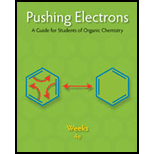
Pushing Electrons
4th Edition
ISBN: 9781133951889
Author: Weeks, Daniel P.
Publisher: Cengage Learning
expand_more
expand_more
format_list_bulleted
Concept explainers
Question
Chapter 2, Problem 16EQ
Interpretation Introduction
Interpretation:
The resonance structure of the given molecule is to be determined
Concept Introduction:
When the electron distribution of a molecule can be depicted correctly in more than one way using different Lewis structures, the drawings are called resonance structures.
Resonance structures have no discrete existence of their own but, taken in combination, describe the true structure of the molecule.
Expert Solution & Answer
Want to see the full answer?
Check out a sample textbook solution
Students have asked these similar questions
1. Arrange the following in order of increasing bond energy (lowest bond energy first, highest bond
energy last). Provide your rationale. C=C, C-F, C=C, C-N, C-C
List the bond order for each example.
What is the major enolate formed when treated with LDA? And why that one?
4. Calculate the total number of sigma bonds and total number of pi bonds in each of the following
compounds.
a.
HH :D:
+1
I
H-N-C-C-O-H
I
H
b.
HH H
Н
:N=C-C-C=C-CEC-H
:0:
total o
H-C-H
H-C = `C-H
I
H.
11
H-C = C=
CH
H
total o
total π
total π
1
H
Chapter 2 Solutions
Pushing Electrons
Ch. 2 - One Lewis structure for the 2-butenyl cation is...Ch. 2 - Prob. 2EQCh. 2 - One structure for the conjugate acid of acetone...Ch. 2 - Similarly, a resonance structure for the conjugate...Ch. 2 - Prob. 5EQCh. 2 - Pairs of unshared electrons can be pushed. One...Ch. 2 - One structure for the acetoxonium ion is Clearly,...Ch. 2 - Prob. 8EQCh. 2 - There are no important resonance structures for...Ch. 2 - Prob. 10EQ
Ch. 2 - Prob. 11EQCh. 2 - Prob. 12EQCh. 2 - Prob. 13EQCh. 2 - Prob. 14EQCh. 2 - Prob. 15EQCh. 2 - Prob. 16EQCh. 2 - Prob. 17EQCh. 2 - The cyclohexane carboxylate anion has a Lewis...Ch. 2 - One Lewis structure for the enolate anion of...Ch. 2 - Prob. 20EQCh. 2 - Prob. 21EQCh. 2 - Prob. 22EQCh. 2 - Prob. 23EQCh. 2 - Prob. 24EQCh. 2 - Prob. 25EQCh. 2 - Prob. 26EQCh. 2 - Prob. 27EQCh. 2 - Prob. 28EQ
Knowledge Booster
Learn more about
Need a deep-dive on the concept behind this application? Look no further. Learn more about this topic, chemistry and related others by exploring similar questions and additional content below.Similar questions
- In the following reaction, what quantity in moles of CH₃OH are required to give off 4111 kJ of heat? 2 CH₃OH (l) + 3 O₂ (g) → 2 CO₂ (g) + 4 H₂O(g) ∆H° = -1280. kJarrow_forwardIndicate the processes in the dismutation of Cu2O.arrow_forward1. Consider these three reactions as the elementary steps in the mechanism for a chemical reaction. 2600 2400 2200 2000 1800 1600 1400 1200 1000 800 Potential Energy (kJ) 600 400 200 0 -200- -400 -600- -800 (i) Cl₂ (g) + Pt(s) → 2Cl (g) + Pt(s) (ii) Cl (g)+ CO (g) + Pt (s) → CICO (g) + Pt (s) Ea = 1550 kJ Ea = 2240 kJ (iii) Cl (g) + CICO (g) → Cl₂CO (g) Ea = 2350 kJ AH=-950 kJ ΔΗ = 575 ΚΙ AH=-825 kJ a. Draw the potential energy diagram for the reaction. Label the data points for clarity. The potential energy of the reactants is 600 kJ Reaction Progress b. What is the overall chemical equation? c. What is the overall change in enthalpy for the above chemical reaction? d. What is the overall amount of activation energy for the above chemical reaction? e. Which reaction intermediate would be considered a catalyst (if any) and why? f. If you were to add 2700kJ of energy to the reaction (e.g. 2700 kl of heat or electricity), would you be able to make the reaction reverse itself (i.e. have…arrow_forward
- draw the enolate anion and the carbonyl that would be needed to make this product through an aldol addition reaction.arrow_forwardDraw the Michael Adduct and the final product of the Robinson annulation reaction. Ignore inorganic byproducts.arrow_forwardDraw the Michael adduct and final product of the Robinson annulation reaction. Ignore inorganic byproductsarrow_forward
- Post Lab Questions. 1) Draw the mechanism of your Diels-Alder cycloaddition. 2) Only one isomer of product is formed in the Diels-Alder cycloaddition. Why? 3) Imagine that you used isoprene as diene - in that case you don't have to worry about assigning endo vs exo. Draw the "endo" and "exo" products of the Diels-Alder reaction between isoprene and maleic anhydride, and explain why the distinction is irrelevant here. 4) This does not hold for other dienes. Draw the exo and endo products of the reaction of cyclohexadiene with maleic anhydride. Make sure you label your answers properly as endo or exo. 100 °C Xylenes ??? 5) Calculate the process mass intensity for your specific reaction (make sure to use your actual amounts of reagent).arrow_forwardIndicate the product(s) A, B C and D that are formed in the reaction: H + NH-NH-CH [A+B] [C+D] hydrazonesarrow_forwardHow can you prepare a 6 mL solution of 6% H2O2, if we have a bottle of 30% H2O2?arrow_forward
- How many mL of H2O2 from the 30% bottle must be collected to prepare 6 mL of 6% H2O2.arrow_forwardIndicate the product(s) B and C that are formed in the reaction: HN' OCH HC1 B + mayoritario C minoritario OCH3arrow_forwardIndicate the product(s) that are formed in the reaction: NH-NH, OCH3 -H₂O OCH3arrow_forward
arrow_back_ios
SEE MORE QUESTIONS
arrow_forward_ios
Recommended textbooks for you
